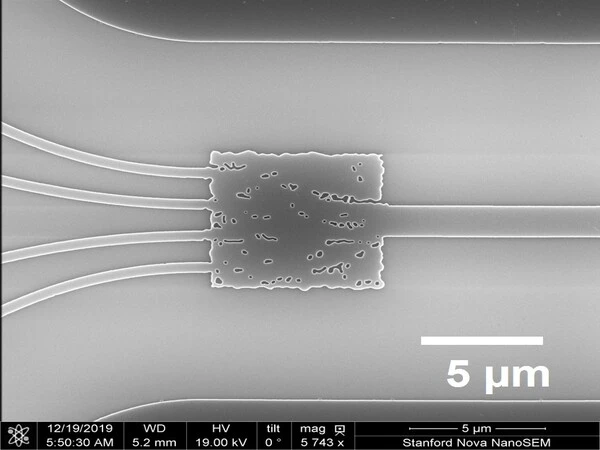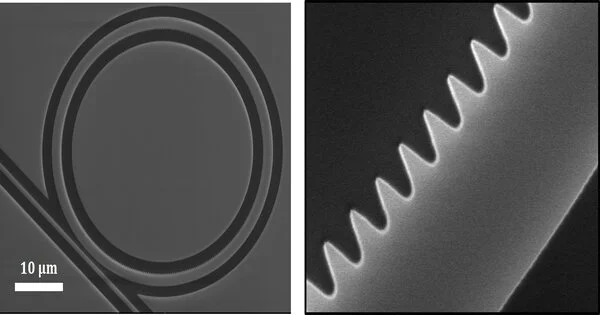Researchers have created a silicon-based optical communications link that can improve data-intensive internet applications ranging from video streaming services to high-capacity stock market transactions. This device could pave the way for the next generation of optical interconnects for use in data-center networks, which serve as the internet’s backbone.
Researchers demonstrated a silicon-based optical communication link that combines two multiplexing technologies to generate 40 optical data channels capable of moving data at the same time. The new chip-scale optical interconnect can transmit 400 GB of data per second, which is roughly the equivalent of 100,000 streaming movies. This could improve data-intensive internet applications ranging from video streaming services to high-capacity stock market transactions.
“As the demand to move more information across the internet grows, we need new technologies to push data rates even higher,” said Peter Delfyett, who led the research team at the University of Central Florida’s College of Optics and Photonics (CREOL). “Because optical interconnects can move more data than electronic interconnects, our work could enable better and faster data processing in the data centers that serve as the internet’s backbone.”
We show that these new frequency combs can be used in fully integrated optical interconnects. All of the photonic components were made from silicon-based material, demonstrating the potential for making optical information handling devices from low-cost, easy-to-manufacture optical interconnects.
Chinmay Shirpurkar
A multi-institutional group of researchers describes the new optical communication link in the Optica Publishing Group journal Optics Letters. It achieves 40 channels by combining a frequency comb light source based on a new photonic crystal resonator developed by the National Institute of Standards and Technology (NIST) with an optimized mode-division multiplexer designed by Stanford University researchers. Each channel can be used to carry information in the same way that different stereo channels, or frequencies, transmit different music stations.
“We show that these new frequency combs can be used in fully integrated optical interconnects,” said Chinmay Shirpurkar, co-first author of the paper. “All of the photonic components were made from silicon-based material, demonstrating the potential for making optical information handling devices from low-cost, easy-to-manufacture optical interconnects.”
In addition to improving internet data transmission, the new technology could be used to build faster optical computers that can provide the high levels of computing power required for artificial intelligence, machine learning, large-scale emulation, and other applications.

Using multiple light dimensions
The new work involved research teams led by Firooz Aflatouni of the University of Pennsylvania, Scott B. Papp from NIST, Jelena Vuckovic from Stanford University and Delfyett from CREOL. It is part of the DARPA Photonics in the Package for Extreme Scalability (PIPES) program, which aims to use light to vastly improve the digital connectivity of packaged integrated circuits using microcomb-based light sources.
The optical link was built with tantalum pentoxide (Ta2O5) waveguides on a silicon substrate formed into a ring with a nanopatterned oscillation on the inner wall. The photonic crystal micro-ring resonator that results converts a laser input into ten different wavelengths. They also created and optimized a mode-division multiplexer, which converts each wavelength into four new beams of varying shapes. The addition of this spatial dimension allows for a fourfold increase in data capacity, resulting in the 40 channels.
Once the data has been encoded onto each beam shape and color, the light is recombined into a single beam and transmitted to its destination. At the final destination, the wavelengths and beam shapes are separated so that each channel can be received and detected independently, without interference from the other transmitted channels.
“An advantage of our link is that the photonic crystal resonator enables easier soliton generation and a flatter comb spectrum than those demonstrated with conventional ring resonators,” said NIST co-first author Jizhao Zang. “These features are advantageous for optical data links.”
Better performance with inverse design
To optimize the mode division multiplexer, the researchers used a computational nanophotonic design approach called photonic inverse-design. This method provides a more efficient way to explore a full range of possible designs while offering smaller footprints, better efficiencies and new functionalities.
“The photonic inverse-design approach makes our link highly customizable to meet the needs of specific applications,” said co-first author Kiyoul Yang from Stanford University.
The new device’s tests matched simulations well and revealed that the channels had low crosstalk of less than -20 dB. The link performed error-free data transmission in 34 of the 40 channels using a PRBS31 pattern, a standard used to test high-speed circuits under stress, while using less than?10 dBm of received optical receiver power.
The researchers are now working to improve the device even further by incorporating photonic crystal micro-ring resonators that produce more wavelengths or by employing more complex beam shapes. To commercialize these devices, a transmitter and receiver chip with high bandwidth, low power consumption, and a small footprint would need to be fully integrated. This could pave the way for the next generation of optical interconnects for data-center networks.















